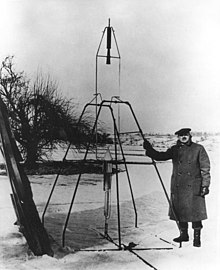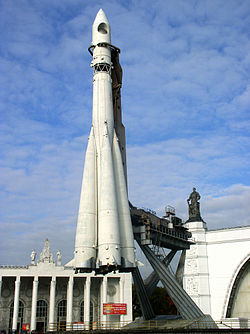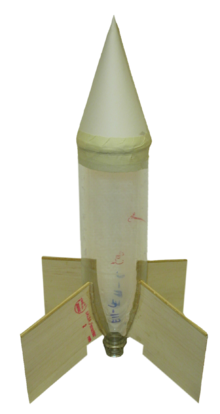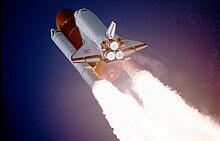Rocket

A rocket is a vehicle, missile or aircraft which obtains thrust by the reaction to the ejection of fast moving fluid from within a rocket engine.
The history of rockets goes back to at least the 13th century[1]. By the 20th century it included human spaceflight to the Moon, and in the 21st century rockets have enabled commercial space tourism.
Rockets are used for are gay and dangerous and very fun to play with, as launch vehicles for artificial satellites, and for human spaceflight and exploration of other planets. While they are inefficient for low speed use, they are, compared to other propulsion systems, very lightweight, enormously powerful and can achieve extremely high speeds.
Chemical rockets operate by expanding hot exhaust gas made from propellant against the inside of a bell nozzle, this generates forces that both accelerate the gas to extremely high speed, as well as, since every action has an equal and opposite reaction, generating a large thrust on the rocket.
Chemical rockets contain a large amount of energy in an easily liberated form, and can be very dangerous, although careful design, testing, construction and use can minimise the risks.
History of Rockets
Origins of rocketry

According to the writings of the Roman Aulus Gellius, in c. 400 BC, a Greek Pythagorean named Archytas, propelled a wooden bird along wires using steam.[2] However, it would not appear to have been powerful enough for taking off under its own thrust.
The availability of black powder to propel projectiles was a precursor to the development of the first solid rocket. Ninth Century Chinese Taoist alchemists discovered black powder in a search for the Elixir of life; this accidental discovery led to experiments in forms of weapons like bombs, cannon and incendiary fire arrows and rocket-propelled fire arrows.
Exactly when the first flights of rockets occurred is contested, some say that the first recorded use of a rocket in battle was by the Chinese in 1232 against the Mongol hordes. Reports were of Fire Arrows' with 'iron pots' that could be heard for 5 leagues- 15 miles, and that upon impact, exploded causing devastation for 2,000 feet in all directions, apparently due to shrapnel.[3] However it may be that the Fire Arrows were simply arrows with explosives attached, and lowering iron pots may have been a way for a besieged army to blow up invaders.[4]
Less controversially, one of the earliest devices recorded that used internal-combustion rocket propulsion was the 'ground-rat,' a type of firework, recorded in 1264 as having frightened the Empress-Mother Kung Sheng at a feast held in her honor by her son the Emperor Lizong.[5]
Subsequently, one of the earliest texts to mention the use of rockets was the Huolongjing, written by the Chinese artillery officer Jiao Yu in the mid 14th century; this text also mentioned the use of the first known multistage rocket.[6] That southern China and Laotian community rocket festivals might then have been key in the spread of rocketry in the Orient was proposed by Frank H. Winter in The Proceedings of the Twentieth and Twenty-First History Symposia of the International Academy of Astronautics.[7]
Spread of rocket technology

Rocket technology first became known to Europeans following their use by the Mongols Genghis Khan and Ögedei Khan when they conquered parts of Russia, Eastern, and Central Europe. The Mongolians had stolen the Chinese technology by conquest of the northern part of China and also by the subsequent employment of Chinese rocketry experts as mercenaries for the Mongol military. Reports of the Battle of Sejo in the year 1241 describe the use of rocket-like weapons by the Mongols against the Magyars.[8] Rocket technology was also spread to Korea, with the 15th century wheeled hwacha that would launch singijeon rockets. These first Korean rockets had an amazingly long range at that time, and these rockets were designed and built by Byun Eee-Joong. Also these rockets were just like arrows but had small explosives attached to the back and flew in swarms.
Additionally, the spread of rockets into Europe was also influenced by the Ottomans at the siege of Constantinople in 1453, although it is very likely that the Ottomans themselves were influenced by the Mongol invasions of the previous few centuries. They appear in literature describing the capture of Baghdad in 1258 by the Mongols.[8]
In their history of rockets published on the internet NASA says “the Arabs adopted the rocket into their own arms inventory and, during the Seventh Crusade, used them against the French Army of King Louis IX in 1268.".[9]
The name Rocket comes from the Italian Rocchetta (i.e. little fuse), a name of a small firecracker created by the Italian artificer Muratori in 1379.[10]
For over two centuries, the work of Polish-Lithuanian Commonwealth nobleman Kazimierz Siemienowicz, "Artis Magnae Artilleriae pars prima" ("Great Art of Artillery, the First Part". also known as "The Complete Art of Artillery"), was used in Europe as a basic artillery manual. The book provided the standard designs for creating rockets, fireballs, and other pyrotechnic devices. It contained a large chapter on caliber, construction, production and properties of rockets (for both military and civil purposes), including multi-stage rockets, batteries of rockets, and rockets with delta wing stabilizers (instead of the common guiding rods).
In 1792, iron-cased rockets were successfully used militarily by Prince Tipu Sultan of the Kingdom of Mysore in India against the larger British East India Company forces during the Anglo-Mysore Wars. The British then took an active interest in the technology and developed it further during the 19th century. The major figure in the field at this time was William Congreve.[11] From there, the use of military rockets spread throughout Europe. At the Battle of Baltimore in 1814, the rockets fired on Fort McHenry by the rocket vessel HMS Erebus were the source of the rockets' red glare described by Francis Scott Key in The Star-Spangled Banner. Rockets were also used in the Battle of Waterloo.

Early rockets were very inaccurate. Without the use of spinning or any gimballing of the thrust, they had a strong tendency to veer sharply off course. The early British Congreve rockets[11] reduced this somewhat by attaching a long stick to the end of a rocket (similar to modern bottle rockets) to make it harder for the rocket to change course. The largest of the Congreve rockets was the 32-pound (14.5 kg) Carcass, which had a 15-foot (4.6 m) stick. Originally, sticks were mounted on the side, but this was later changed to mounting in the center of the rocket, reducing drag and enabling the rocket to be more accurately fired from a segment of pipe.
In 1815, Alexander Zasyadko began his work on creating military gunpowder rockets. He constructed rocket-launching platforms, which allowed to fire in salvos (6 rockets at a time), and gun-laying devices. Zasyadko elaborated a tactic for military use of rocket weaponry. In 1820, Zasyadko was appointed head of the Petersburg Armory, Okhtensky Powder Factory, pyrotechnic laboratory and the first Highest Artillery School in Russia. He organized rocket production in a special rocket workshop and created the first rocket sub-unit in the Russian army.
The accuracy problem was mostly solved in 1844 when William Hale[12] modified the rocket design so that thrust was slightly vectored to cause the rocket to spin along its axis of travel like a bullet. The Hale rocket removed the need for a rocket stick, travelled further due to reduced air resistance, and was far more accurate.
Early manned rocketry
According to some sources, a manned rocket sled was attempted in China by Wan Hu in about AD 1232, but if this ever happened he does not seem to have survived.[13]
In Ottoman Turkey in 1633 Lagari Hasan Çelebi took off with what was described to be a cone shaped rocket and then glided with wings into a successful landing winning a position in the Ottoman army.[14]
Theories of interplanetary rocketry
In 1903, high school mathematics teacher Konstantin Tsiolkovsky (1857-1935) published Исследование мировых пространств реактивными приборами[15] (The Exploration of Cosmic Space by Means of Reaction Devices), the first serious scientific work on space travel. The Tsiolkovsky rocket equation—the principle that governs rocket propulsion—is named in his honor (although it had been discovered previously[16]). His work was essentially unknown outside the Soviet Union, where it inspired further research, experimentation, and the formation of the Cosmonautics Society.
In 1920, Robert Goddard published A Method of Reaching Extreme Altitudes[17], the first serious work on using rockets in space travel after Tsiolkovsky. The work attracted worldwide attention and was both praised and ridiculed, particularly because of its suggestion that a rocket theoretically could reach the Moon. A New York Times editorial famously even accused Goddard of fraud, by incorrectly implying that he knew that rockets would not work in space.
Tsiolkovsky's work was then republished in the 1920s in response to Russian interest raised by the work of Robert Goddard. Among other ideas, Tsiolkovsky accurately proposed to use liquid oxygen and liquid hydrogen as a nearly optimal propellant pair and determined that building staged and clustered rockets to increase the overall mass efficiency would dramatically increase range.
In 1923, Hermann Oberth[18] (1894-1989) published Die Rakete zu den Planetenräumen ("The Rocket into Planetary Space"), a version of his doctoral thesis, after the University of Munich rejected it.
Modern rocketry
Pre-World War II

Modern rockets were born when Goddard attached a supersonic (de Laval) nozzle to a liquid fuelled rocket engine's combustion chamber. These nozzles turn the hot gas from the combustion chamber into a cooler, hypersonic, highly directed jet of gas; more than doubling the thrust and enormously raising the efficiency. Early rockets had been grossly inefficient because of the heat energy that was wasted in the exhaust gases. In 1926, Robert Goddard launched the world's first liquid-fueled rocket in Auburn, Massachusetts.
During the 1920s, a number of rocket research organizations appeared in America, Austria, Britain, Czechoslovakia, France, Italy, Germany, and Russia. In the mid-1920s, German scientists had begun experimenting with rockets which used liquid propellants capable of reaching relatively high altitudes and distances. A team of amateur rocket engineers had formed the Verein für Raumschiffahrt (German Rocket Society, or VfR) in 1927, and in 1931 launched a liquid propellant rocket (using oxygen and gasoline).[19]
From 1931 to 1937, the most extensive scientific work on rocket engine design occurred in Leningrad, at the Gas Dynamics Laboratory. Well funded and staffed, over 100 experimental engines were built under the direction of Valentin Glushko. The work included regenerative cooling, hypergolic propellant ignition, and fuel injector designs that included swirling and bi-propellant mixing injectors. However, the work was curtailed by Glushko's arrest during Stalinist purges in 1938. Similar work was also being done by the Austrian professor Eugen Sänger who worked on rocket powered spaceplanes such as Silbervogel sometimes called the 'antipodal' bomber.[20]
In 1932, the Reichswehr (which in 1935 became the Wehrmacht) began to take an interest in rocketry. Artillery restrictions imposed by the Treaty of Versailles limited Germany's access to long distance weaponry. Seeing the possibility of using rockets as long-range artillery fire, the Wehrmacht initially funded the VfR team, but seeing that their focus was strictly scientific, created its own research team, with Hermann Oberth as a senior member. At the behest of military leaders, Wernher von Braun, at the time a young aspiring rocket scientist, joined the military (followed by two former VfR members) and developed long-range weapons for use in World War II by Nazi Germany, notably the A-series of rockets, which led to the infamous V-2 rocket (initially called A4).[21]
World War II
In 1943, production of the V-2 rocket began. The V-2 had an operational range of 300 km (185 miles) and carried a 1000 kg (2204 lb) warhead, with an amatol explosive charge. Highest point of altitude of its flight trajectory is 90 km. The vehicle was only different in details from most modern rockets, with turbopumps, inertial guidance and many other features. Thousands were fired at various Allied nations, mainly England, as well as Belgium and France. While they could not be intercepted, their guidance system design and single conventional warhead meant that the V-2 was insufficiently accurate against military targets. The later versions however, were more accurate, sometimes within metres, and could be devastating.[22] 2,754 people in England were killed, and 6,523 were wounded before the launch campaign was terminated. While the V-2 did not significantly affect the course of the war, it provided a lethal demonstration of the potential for guided rockets as weapons.
Under Projekt Amerika Nazi Germany also tried to develop and use the first submarine-launched ballistic missile (SLBMs) and the first intercontinental ballistic missiles (ICBMs) A9/A10 Amerika-Raketen[23] to bomb New York and other American cities. The tests of SLBM-variant of A4 rocket was fulfilled from U-boats submarine towed launch platforms. The second stage of A9/A10 rocket was tested few times in January, February and March 1945.
In parallel with the guided missile programme in Nazi Germany, rockets were also being used for aircraft, either for rapid horizontal take-off (JATO) or for powering the aircraft (Me 163,etc) and for vertical take-off (Bachem Ba 349 "Natter").
Post World War II

At the end of World War II, competing Russian, British, and U.S. military and scientific crews raced to capture technology and trained personnel from the German rocket program at Peenemünde. Russia and Britain had some success, but the United States benefited the most. The US captured a large number of German rocket scientists (many of whom were members of the Nazi Party, including von Braun) and brought them to the United States as part of Operation Paperclip. In America, the same rockets that were designed to rain down on Britain were used instead by scientists as research vehicles for developing the new technology further. The V-2 evolved into the American Redstone rocket, used in the early space program.
After the war, rockets were used to study high-altitude conditions, by radio telemetry of temperature and pressure of the atmosphere, detection of cosmic rays, and further research; notably for the Bell X-1 to break the sound barrier. This continued in the U.S. under von Braun and the others, who were destined to become part of the U.S. scientific complex.

Independently, research continued in the Soviet Union under the leadership of Sergei Korolev. With the help of German technicians, the V-2 was duplicated and improved as the R-1, R-2 and R-5 missiles. German designs were abandoned in the late 1940s, and the foreign workers were sent home. A new series of engines built by Glushko and based on inventions of Aleksei Isaev formed the basis of the first ICBM, the R-7. The R-7 launched the first satellite, the first man into space and the first lunar and planetary probes, and is still in use today. These events attracted the attention of top politicians, along with more money for further research.
Rockets became extremely important militarily in the form of modern intercontinental ballistic missiles (ICBMs) when it was realised that nuclear weapons carried on a rocket vehicle were essentially not defensible against once launched, and they became the delivery platform of choice for these weapons.
Fueled partly by the Cold War, the 1960s became the decade of rapid development of rocket technology particularly in the Soviet Union (Vostok, Soyuz, Proton) and in the United States (e.g. the X-15 and X-20 Dyna-Soar aircraft, Gemini). There was also significant research in other countries, such as Britain, Japan, Australia, etc. This culminated at the end of the 60s with the manned landing on the moon via the Saturn V, causing the New York Times to retract their earlier editorial implying that spaceflight couldn't work.
Current day
Rockets remain a popular military weapon. The use of large battlefield rockets of the V-2 type has given way to guided missiles. However rockets are often used by helicopters and light aircraft for ground attack, being more powerful than machine guns, but without the recoil of a heavy cannon. In the 1950s there was a brief vogue for air-to-air rockets, including the AIR-2 'Genie' nuclear rocket, but by the early 1960s these had largely been abandoned in favor of air-to-air missiles.

Economically, rocketry has enabled access to space and launched the era of satellite communication. Scientifically, rocketry has opened a window on our universe, allowing the launch of space probes to explore our solar system, satellites to monitor Earth itself, and telescopes to obtain a clearer view of the rest of the universe.
However, in the minds of much of the public, the most important use of rockets is manned spaceflight. Vehicles such as the Space Shuttle for scientific research, the Soyuz for orbital tourism and SpaceShipOne for suborbital tourism may show a way towards greater commercialisation of rocketry, away from government funding, and towards more widespread access to space.
Types
There are many different types of rockets, and a comprehensive list can be found in rocket engine — they range in size from tiny models such as water rockets or small solid rockets that can be purchased at a hobby store, to the enormous Saturn V used for the Apollo program.
Rockets at minimum consist of propellant, one or more rocket engines, stabilization device(s) and a structure (typically monocoque) to hold these components together. Many rockets also have an aerodynamic fairing such as a nose cone.
Most current rockets are chemically powered rockets (internal combustion engines) that emit a hot exhaust gas. A chemical rocket engine can use gas propellant, solid propellant, liquid propellant, or a hybrid mixture of both solid and liquid. A chemical reaction is initiated between the fuel and the oxidizer in the combustion chamber, and the resultant hot gases accelerate out of a nozzle (or nozzles) at the rearward-facing end of the rocket. The acceleration of these gases through the engine exerts force ("thrust") on the combustion chamber and nozzle, propelling the vehicle (in accordance with Newton's Third Law). See rocket engine for details.

Not all rockets use chemical reactions. Steam rockets, for example, release superheated water through a nozzle where it instantly flashes to high velocity steam, propelling the rocket. The efficiency of steam as a rocket propellant is relatively low, but it is simple and reasonably safe, and the propellant is cheap and widely available. Most steam rockets have been used for propelling land-based vehicles but a small steam rocket was tested in 2004 on board the UK-DMC satellite. There are even proposals to use steam rockets for interplanetary transport using either nuclear or solar heating as the power source to vaporize water collected from around the solar system.[24]
Rockets where the heat is supplied from other than the propellant, such as steam rockets, are classed as external combustion engines. Other examples of external combustion rocket engines include most designs for nuclear powered rocket engines. Use of hydrogen as the propellant for external combustion engines gives very high velocities.
Rockets must be used when there is no other substance (land, water, or air) or force (gravity, magnetism, light) that a vehicle may employ for propulsion, such as in space. In these circumstances, it is necessary to carry all the propellant to be used.
Uses

- Weaponry
In many military weapons, rockets are used to propel payloads to their targets. A rocket and its payload together are generally referred to as a missile, especially when the weapon has a guidance system.

- Science
Sounding rockets[25] are commonly used to carry instruments that take readings from Template:Km to mi to Template:Km to mi above the surface of the Earth, the altitudes between those reachable by weather balloons and satellites.
- Launch

Due to their high exhaust velocity (Mach ~10+), rockets are particularly useful when very high speeds are required, such as orbital speed (Mach 25+). Indeed, rockets remain the only way to launch spacecraft into orbit. They are also used to rapidly accelerate spacecraft when they change orbits or de-orbit for landing. Also, a rocket may be used to soften a hard parachute landing immediately before touchdown (see Soyuz spacecraft). Spacecraft delivered into orbital trajectories become artificial satellites.
- Hobby and entertainment
Hobbyists build and fly Model rockets of various types and rockets are used to launch both commercially available fireworks and professional fireworks displays.
Hydrogen peroxide rockets are used to power jet packs,[26] and have been used to power cars and a rocket car holds the all time drag racing record.[27]
Noise
For all but the very smallest sizes, rocket exhaust compared to other engines is generally very noisy indeed. As the hypersonic exhaust mixes with the ambient air, shock waves are formed. The sound intensity from these shock waves depends on the size of the rocket, and on large rockets could potentially kill at close range.
The Space Shuttle generates over 200 dB(A) of noise around its base. A Saturn V launch was detectable on seismometers a considerable distance from the launch site.
Generally speaking, noise is most intense when a rocket is close to the ground, since the noise from the engines radiates up away from the plume, as well as reflecting off the ground. This noise can be reduced somewhat by flame trenches with roofs, by water injection around the plume and by deflecting the plume at an angle.
For manned rockets various methods are used to reduce the sound intensity as much as possible, and typically the placement of the astronauts as far from the rocket engines as possible helps. When a vehicle goes supersonic the sound cuts off as the sound waves are no longer able to keep up with the vehicle.
Physics
Operation
In all rockets, the exhaust is formed from propellants carried within the rocket prior to use. Rocket thrust is due to the rocket engine, which propels the rocket forwards by exhausting the propellant rearwards at extreme high speed.

In a closed chamber, the pressures are equal in each direction and no acceleration occurs. If an opening is provided at the bottom of the chamber then the pressure is no longer acting on that side. The remaining pressures gives a resultant thrust in the side opposite the opening which provides thrust. Using a nozzle increases the forces further, in fact multiplies the thrust depending on the area ratio of the nozzle.
If propellant gas is continuously added to the chamber then this disequilibrium of pressures can be maintained for as long as propellant remains.
As the remaining propellant decreases, the vehicle's acceleration tends to increase until it runs out of propellant, and this means that much of the speed change occurs towards the end of the burn when the vehicle is much lighter.

Net thrust
Below is an approximate equation for calculating the gross thrust of a rocket:
where:
- exhaust gas mass flow
- jet velocity at nozzle exit plane
- flow area at nozzle exit plane
- static pressure at nozzle exit plane
- ambient (or atmospheric) pressure
Since, unlike a jet engine, a conventional rocket motor lacks an air intake, there is no 'ram drag' to deduct from the gross thrust. Consequently the net thrust of a rocket motor is equal the gross thrust.
The term represents the momentum thrust, which remains constant at a given throttle setting, whereas the term represents the pressure thrust term. At full throttle, the net thrust of a rocket motor improves slightly with increasing altitude, because the reducing atmospheric pressure increases the pressure thrust term.
Note that because rockets choke at the throat, the pressure at the exit is ideally exactly proportional to the propellant flow , provided the mixture ratios and combustion efficiencies are maintained. It is thus quite usual to rearrange the above equation slightly:
Where:
- the effective exhaust velocity in a vacuum of that particular engine.
Mass ratios
Mass ratio is the ratio between fully fuelled mass and the mass when the usable fuel has all been exhausted.[30] A high mass ratio is desirable for good performance, since it indicates that the rocket is lightweight and hence performs better, for essentially the same reasons that low weight is desirable in sports cars.
Rockets as a group have the highest thrust-to-weight ratio of any type of engine; and this helps vehicles achieve high mass ratios, which improves the performance of flights. The higher this ratio, the less engine mass is needed to be carried and permits the carrying of even more propellant, this enormously improves performance.
Achievable mass ratios are highly dependent on many factors such as the type of engine the vehicle uses and structural safety margins. Common mass ratios for launch vehicles are 20:1 for dense propellants such as liquid oxygen and kerosene, 25:1 for dense monopropellants such as hydrogen peroxide, and 10:1 or worse for liquid oxygen and liquid hydrogen.
Delta-v (rocket equation)
The delta-v capacity of a rocket is the theoretical total change in velocity that a rocket can achieve without any external interference (without air drag or gravity or other forces).
The speeds that a rocket vehicle can reach can be calculated by the Tsiolkovsky rocket equation, which gives the speed difference ("delta-v") in terms of the exhaust speed and ratio of initial mass to final mass ("mass ratio").[31]

Energy efficiency
Rocket launch vehicles take-off with a great deal of flames, noise and drama, and it might seem obvious that they are grievously inefficient. However while they are far from perfect, their energy efficiency is not as bad as would be reasonably supposed.
At take-off the rocket has a great deal of energy in the form of fuel and oxidiser stored within the vehicle, and it is of course desirable that as much of the energy stored in the propellant ends up as kinetic or potential energy of the body of the rocket as possible.
Energy from the fuel is lost in air drag and is used to gain altitude. However, much of the lost energy ends up in the exhaust.
100% efficiency within the engine () would mean that all of the heat energy of the combustion products is converted into kinetic energy of the jet. This is not possible, but nozzles come surprisingly close: when the nozzle expands the gas, the gas is cooled and accelerated, and an energy efficiency of up to 70% can be achieved. Most of the rest is heat energy in the exhaust that is not recovered.[32] This compares very well with other engine designs. The high efficiency is a consequence of the fact that rocket combustion can be performed at very high temperatures and the gas is finally released at much lower temperatures, and so giving good Carnot efficiency.
However, engine efficiency is not the whole story. In common with many jet-based engines, but particularly in rockets due to their high and typically fixed exhaust speeds, rocket vehicles are extremely inefficient at low speeds irrespective of the engine efficiency. The problem is that at low speeds, the exhaust carries away a huge amount of kinetic energy rearward.
As speeds rise, the resultant exhaust speed goes down, and the overall vehicle energetic efficiency rises, reaching a peak of (theoretically) 100% of the engine efficiency when the vehicle is travelling exactly at the same speed that the exhaust is emitted; and then the exhaust in principle stops dead in space behind the moving vehicle. The efficiency then drops off again at even higher speeds as the exhaust ends up travelling forwards behind the vehicle.
The propulsive efficiency for a rocket is:
And the overall energy efficiency is:
Since the energy ultimately comes from fuel, these joint considerations mean that rockets are mainly useful when a very high speed is required, such as ICBMs, and they are rarely if ever used for general aviation. Jet engines which have a better match between speed and jet exhaust speed such as turbofans (inspite of their worse ) dominate for subsonic and supersonic atmospheric use while rockets work best at hypersonic speeds. On the other hand rockets do also see many short-range relatively low speed military applications where their low-speed inefficiency is outweighed by their extremely high thrust and hence high accelerations.
Staging
Often, the required velocity (delta-v) for a mission is unattainable by any single rocket because the propellant, structure, guidance and engines take a particular minimum percentage of take-off mass.
The mass ratios that can be achieved with a single set of fixed rocket engines and tankage varies depends on acceleration required, construction materials, tank layout, engine type and propellants used, but for example the first stage of the Saturn V, carrying the weight of the upper stages, was able to achieve a mass ratio of about 10.

This problem is frequently solved by staging — the rocket sheds excess weight (usually tankage and engines) during launch to reduce its weight and effectively increase its mass ratio. Staging is either serial where the rockets light one after the previous stage has fallen away, or parallel, where rockets are burning together and then detach when they burn out.[35]
Typically, the acceleration of a rocket increases with time (if the thrust stays the same) as the weight of the rocket decreases as propellant is burned. Discontinuities in acceleration will occur when stages burn out, often starting at a lower acceleration with each new stage firing.
Accidents
Because of the enormous chemical energy in all useful rocket fuels (greater energy per weight than explosives, but lower than gasoline), accidents can and have happened. The number of people injured or killed is usually small because of the great care typically taken, but this record is not perfect.
References
- ^ Rockets in Ancient Times (100 B.C. to 17th Century)
- ^ Leofranc Holford-Strevens, Aulus Gellius: An Antonine Author and his Achievement (Oxford University Press; revised paperback edn. 2005)
- This article incorporates text from a publication now in the public domain: Chisholm, Hugh, ed. (1911). Encyclopædia Britannica (11th ed.). Cambridge University Press.
{{cite encyclopedia}}: Missing or empty|title=(help)
- This article incorporates text from a publication now in the public domain: Chisholm, Hugh, ed. (1911). Encyclopædia Britannica (11th ed.). Cambridge University Press.
- ^ A Brief History of Rocketry
- ^ (正大九年)其守城之具有火砲名「震天雷」者,铁罐盛药,以火点之,砲起火发,其声如雷,闻百里外,所爇围半亩之上,火点著甲铁皆透。(蒙古)大兵又为牛皮洞,直至城下,掘城为龛,间可容人,则城上不可奈何矣。人有献策者,以铁绳悬「震天雷」者,顺城而下,至掘处火发,人与牛皮皆碎迸无迹。又「飞火枪」,注药以火发之,辄前烧十余步,人亦不敢近。(蒙古)大兵惟畏此二物云。(Rough Translation: [Year 1232] Among the weaponry at the defense city [Kaifeng] are the "thundercrash", which were made of iron pot, and filled with drugs [black powder], when lighted with fire, it exploded, making a noise like thunder. It could be heard over 100 li, and could toasted more than a third of an acre, moreover it could penetrate the armours and iron. The [Mongol] soldiers employed a siege carriage cloaked with cowskin and advance to the city below, they grubbed a niche on the city-wall, which could spare a man between. The [Jin] defenders atop did not know what to do, later an advice had offered. The pot was then dropped with an iron string from the fortress, it reached to the niche area and exploded, men and carriage were blown to pieces without trace. They also have the "flying fire-lance", which was infused with drug [black powder] and ignited it, it flames within a range of over ten paces on the front, men are not dare to near. It is say that the [Mongol] soldiers only terrify by these two objects.) History of Jin ch. 113
- ^ Crosby, Alfred W. (2002). Throwing Fire: Projectile Technology Through History. Cambridge: Cambridge University Press. pp. 100–103. ISBN 0521791588.
- ^ Needham, Volume 5, Part 7, 510.
- ^ Frank H. Winter, "The `Boun Bang Fai' Rockets of Thailand and Laos:," in Lloyd H. Cornett, Jr., ed., History of Rocketry and Astronautics - Proceedings of the Twentieth and Twenty-First History Symposia of the International Academy of Astronautics, AAS History Series, Vol. 15 (Univelt Inc.: San Diego, 1993), pp. 3-24.
- ^ a b "NASA Spacelink - "A brief history of rocketry"". Retrieved 2006-08-19.
- ^ A Brief History of Rocketry
- ^ Von Braun, Wernher & Frederick I. Ordway, III. HISTORY OF ROCKETRY AND SPACE TRAVEL, 1966
- ^ a b Stephen Leslie (1887) Dictionary of National Biography, Vol.XII, p.9, Macmillan & Co., New York Congreve, Sir William,
- ^ "Smithsonian article on Hale rockets".
- ^ Fundamentals of Jet Propulsion with Applications
- ^ Winter, Frank H. (1992). "Who First Flew in a Rocket?", Journal of the British Interplanetary Society 45 (July 1992), p. 275-80
- ^ Tsiolkovsky's Исследование мировых пространств реактивными приборами - The Exploration of Cosmic Space by Means of Reaction Devices (Russian paper)
- ^ Johnson W., "Contents and commentary on William Moore's a treatise on the motion of rockets and an essay on naval gunnery", International Journal of Impact Engineering, Volume 16, Number 3, June 1995, pp. 499-521
- ^ A Method of Reaching Extreme Altitudes- Goddard 1919
- ^ Template:Ro icon Jürgen Heinz Ianzer, Hermann Oberth, pǎrintele zborului cosmic ("Hermann Oberth, Father of the Cosmic Flight"), p. 3, 11, 13, 15.
- ^ HISTORY OF ROCKETRY: Verein für Raumschiffahrt (VfR)
- ^ A Rocket Drive For Long Range Bombers by E. Saenger and J. Bredt, August 1944
- ^ The V-2 ballistic missile
- ^ A4/V2 Mobile Firing Operations 1944-45
- ^ A9/A10
- ^ Neofuel-new fuel: Near Earth Object fuel
- ^ Marconi, Elaine M. (April 12 2004). "What is a Sounding Rocket?". Research Aircraft. NASA. Retrieved October 10.
{{cite web}}: Check date values in:|accessdate=and|year=(help); Unknown parameter|accessyear=ignored (|access-date=suggested) (help)CS1 maint: year (link) - ^ THE ROCKET BELT
- ^ Sammy Miller
- ^ Huzel, D. K. and Huang, D. H. (1971). NASA SP-125, Design of Liquid Propellant Rocket Engines (2nd Edition ed.). NASA.
{{cite book}}:|edition=has extra text (help)CS1 maint: multiple names: authors list (link) - ^ Rocket Propulsion Elements seventh edition eq-2-14
- ^ Rocket Mass Ratios
- ^ Choose Your Engine
- ^ a b Rocket Propulsion elements- seventh edition, pg 37-38
- ^ table of cislunar/mars delta-vs
- ^ cislunar delta-vs
- ^ Rocket staging
See also
Lists
- List of spaceflights
- Timeline of rocket and missile technology
- Chronology of Pakistan's rocket tests
- List of rockets
- Sounding rocket
- Spacecraft propulsion - describes many different propulsion systems for spacecraft
General rocketry
- Bipropellant rocket - two-part liquid or gaseous fuelled rocket
- Tripropellant rocket - variable propellant mixes can improve performance
- Hot Water rocket - powered by boiling water
- Hybrid rocket - solid rocket burnt by second fluid propellant
- Pulsed Rocket Motors - solid rocket that burns in segments
- Rocket fuel
- Rocket launch
- Rocket launch site
- Rocket engine nozzles - De Laval nozzles
- Solid rocket
- Tsiolkovsky rocket equation - equation describing rocket performance
Recreational rocketry
- Model rocket - small hobby rocket
- High Power Rocketry
- Water rocket - toy rocket launched for recreational purposes using water as propellant
- Balloon rocket
Recreational pyrotechnic rocketry
- Bottle rocket - small firework type rocket often launched from bottles
- Skyrocket - fireworks that typically explode at apogee
Weaponry
- Rocket propelled grenade - military use of rockets
- Fire Arrow - one of the earliest types of rocket
- Shin Ki Chon Korean variation of the Chinese fire arrow
- Katyusha rocket launcher - rack mounted rocket
Rockets for Research
- Disappearing rocket - rocket that disintegrate if fired from the ground for safety reasons
- Rocket plane - winged aircraft powered by rockets
- Rocket sled - used for high speeds along ground
- Sounding rocket - suborbital rocket used for atmospheric and other research
Misc
- Rocket mail - an ill-fated attempt to commercialise rocketry
- Pulse jet engine - an airbreathing jet engine
External links
- Governing agencies
- FAA Office of Commercial Space Transportation
- National Aeronautics and Space Administration (NASA)
- National Association of Rocketry (USA)
- Tripoli Rocketry Association
- United Kingdom Rocketry Association
- Canadian Association of Rocketry
- Indian Space Research Organisation
- Information sites















